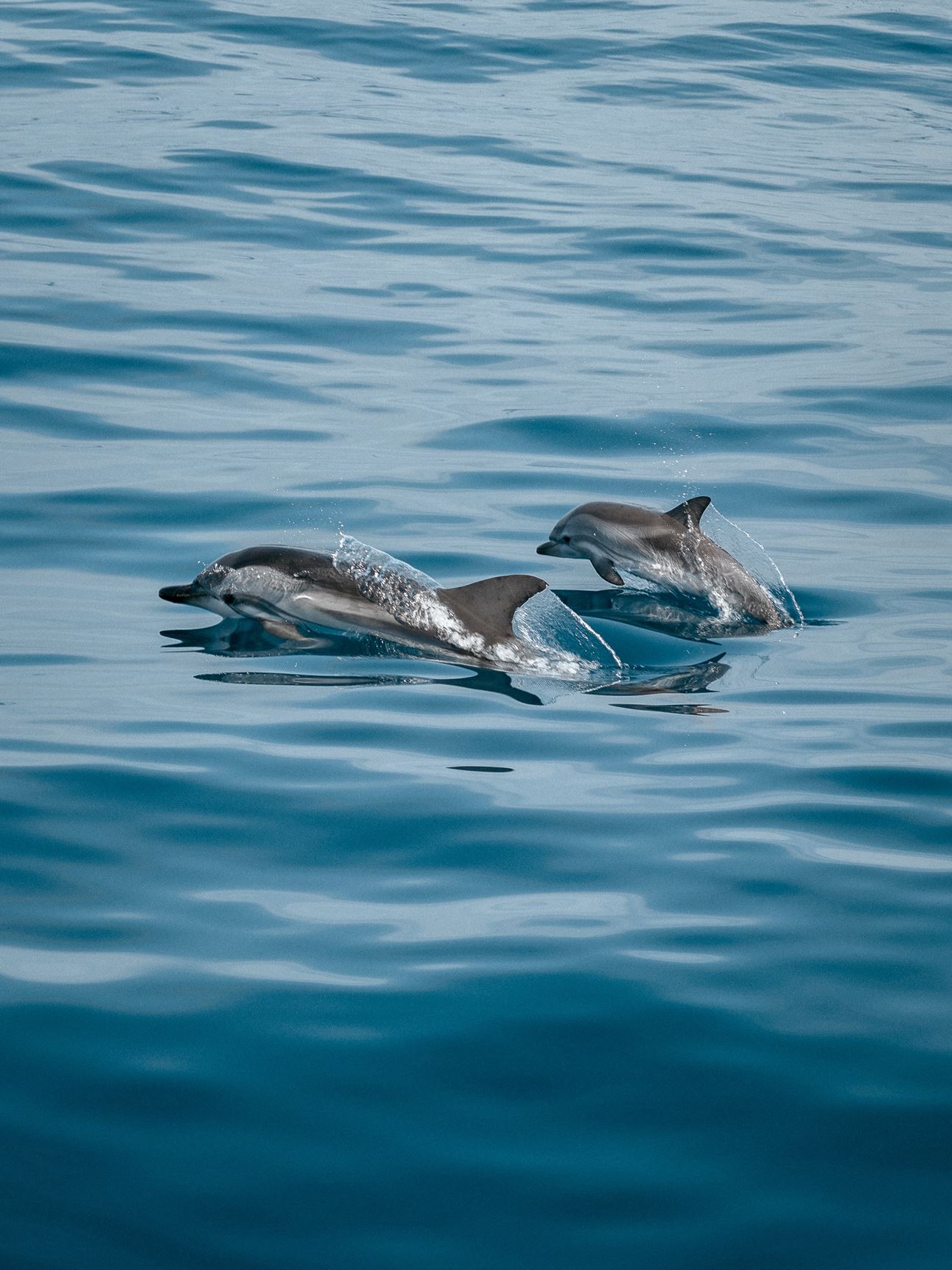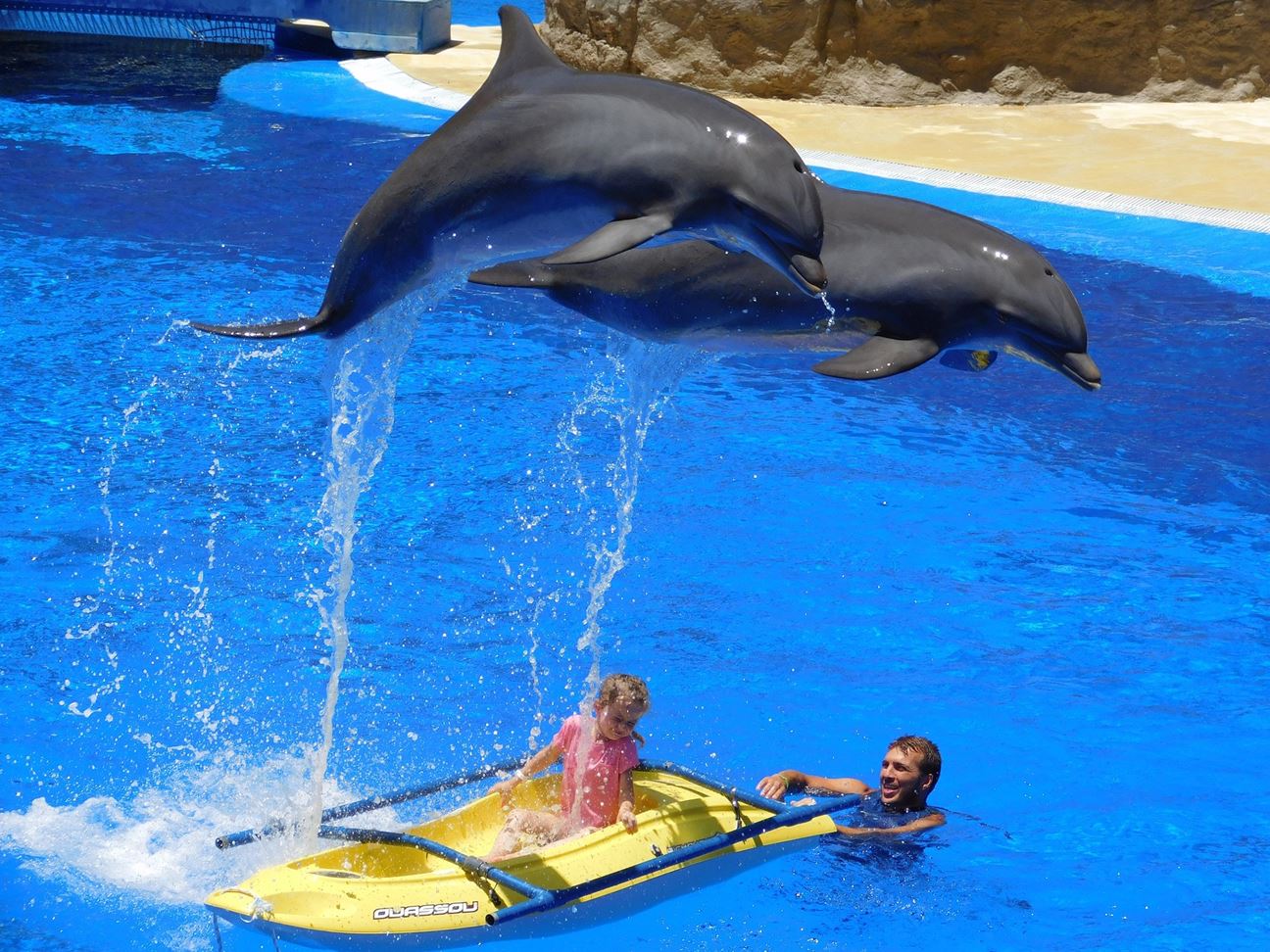Take a deep dive and know more about the dolphin world—from where they live to challenges they are facing in today's times!
The National Dolphin Day is celebrated every year on 14 April across America. It is a day where animal lovers come together to speak for the beloved marine mammals who have no voice. To call for improved standards for dolphin welfare and to raise awareness about the growing plight of the dolphins.
Dolphins are enchanting marine animals that have always bonded well with humans. These adorable creatures are known for their friendliness and intelligence. Several dolphin species are found all over the world. Unfortunately, dolphins are facing survival challenges due to many human activities. Dolphins are incredibly important to our ecosystem, and so learning more about them is a great way to appreciate their worth and value.
This article talks about different dolphins, their habitats, the threats they are currently facing, and ways we can help dolphins around the world. Towards the end, you will find some interesting dolphin facts that you can share with your family and friends.

History of the National Dolphin Day
As a part of the American Veterinary Medical Association Pet Health Awareness Events, the National Dolphin Day is celebrated on 14 April every year. This day is recognised to celebrate the beauty of this gorgeous cetacean mammal. While the exact origin of this day is unknown, this day still helps educate thousands of people from around the world about dolphins.
Types of Dolphins
Currently, there are close to 50 dolphin species which include oceanic dolphins, freshwater dolphins, and porpoises. Many a time, the word dolphin is used interchangeably to describe similar aquatic mammals - like whales and porpoises. Furthermore, some dolphin species get further split into sub-species. For example, the Common Dolphin is further divided into long-beaked and short-beaked. Add to that many local names given to these dolphins. And so it is nearly impossible to come up with an accurate number of dolphin species.
Where Do Dolphins Live?
 A Pacific white-sided dolphin jumping out of the waters along the shores of British Colombia
A Pacific white-sided dolphin jumping out of the waters along the shores of British Colombia
The world’s largest ocean - the Pacific Ocean is home to many dolphin species including the Pacific White-Sided Dolphin that lives in the North Pacific Ocean, Pacific Bottlenose Dolphin found in the waters extending from Japan to Australia, Chinese White Dolphin seen in the waters near the shores of Southeast Asia, Hector’s Dolphin near the coasts of New Zealand, and Spinner Dolphins along the Pacific coast of Central America.
In the Atlantic Ocean, dolphin species such as Atlantic Bottlenose Dolphin are found off the coasts of the United States and even South Africa, Atlantic Spotted Dolphin in the western Atlantic Ocean, Atlantic White-Sided Dolphin are seen in the waters around Greenland, and Common Dolphin can be found in the northern and southern Atlantic Oceans.
The Indian Ocean Bottlenose Dolphins and the Indian Ocean Humpback Dolphins are the most commonly found dolphins in the Indian Ocean.
Threats to Dolphins around the world
The biggest threat that the dolphins face is due to human actions. In some cases, dolphins pose a threat of direct killing for the purpose of food, bait, or even sport. In other cases, dolphins die indirectly due to overfishing that happens in the rivers and the sea. Dolphins are also at the risk of getting killed due to pollution and contamination of seawater - deliberate or accidental. Some examples of marine pollution include chemical pollution caused by the industries dumping large amounts of PCBs (short for PolyChlorinated Biphenyls) in the sea, oil pollution from the spills and floating oil slicks, and noise pollution caused by powerful underwater sonar.
Ways to Help Protect Dolphins
One sure way to help the dolphins is to stay informed about the many ways you can protect them. As seen earlier, dolphins face an enormous challenge from human activities - direct and indirect. Here are some ways you can help save a dolphin:
- Avoid the use of single-use plastics - Disposable plastics contribute a very large percentage to marine pollution. Millions of tons of plastic enter the ocean each year. This in turn leads to the marine animals ingesting them or getting entangled in them.
- Be a part of beach clean-up drive - It is the trash on the beaches and river banks that eventually end up in the waters. Join a beach clean-up community - you can find them almost everywhere. Each item of plastic waste picked from the beach will be one less item in the sea.
- Watch your carbon footprint - There are many ways to do that. Switching off lights when leaving the room, avoiding the use of plastic utensils at home, taking public transport to work, and many more.
- Avoid contributing to the captive marine life - This includes avoiding experiences like 'swim with the dolphins' or the supposedly ‘educational’ aquariums. Keep in mind, that the dolphins suffer in captivity and are subjected to horrible living conditions and cruel training methods.
- Be mindful of the seafood you consume - Unsustainable and unethical fishing practices lead to the unintended killing of many marine species. Due to overfishing, dolphins all over the world are at great risk of dying as a result of bycatch.
- Also, be mindful of the food your pets consume - There have been reports that a lawsuit was filed against a well-known cat food brand due to their misleading ‘dolphin-safe labelling’. Similarly, there has been a controversial claim that a few of the packaged dog food products in Japan contained dolphin meat. Make sure you read labels when buying food for your pets.
Dolphins are Wildlife, Not Entertainment. And so, the Dolphin Entertainment must Stop!
Let us all seriously discourage the use of dolphins in entertainment
You probably must have seen many travel brochures and zoo advertising happy-looking dolphins playing with kids! But let us not be fooled by their smiling faces. And while it may look like they are smiling, unfortunately, they are not. Dolphine smiles are just a physical anomaly. Dolphins used in the entertainment industry suffer silently all the while. They are harshly trained to wave at the audience, walk on their tails, and even communicate with the audience. Dolphins are also subjected to consistent noisy human interactions, loud music, and are made to live inside small water tanks. It is easy to spot a stressed dolphin. You will see that this dolphin is lifelessly floating around in circles and will at times even gnaw at the walls. Dolphin entertainment destroys their families too. Most offspring, which are bred in captivity, are often traded from venue to venue.
But there is hope for the dolphins. Many cruise companies and travel agencies have stopped the sale of captive dolphin entertainment. This is great news, and hopefully, many more will follow suit. These gorgeous animals deserve to live in their natural habitats. And the only place where humans should see them should be in the wild or protected seaside sanctuaries.
How to Observe and Celebrate National Dolphin Day?
While the National Dolphin Day is observed on 14 April, the celebrations must continue. Here are some ways to celebrate National Dolphin Day:
- If you live in a city, you can volunteer with a local group to help clean up the trash items from the rivers. The trash along the park or the sides of the roads adds to the pollution of water and land habitats, thus making it a bit more unlivable for the dolphins. If you have a beach nearby, a cleanup drive along the beach can ensure that the trash doesn’t end up in the water. You can also organise a garbage collection drive in your area.
- Gather your friends and family and watch films/documentaries that talk about the dolphins. This way, you can educate and discuss among your peers and can then further spread the word. Some documentaries to watch can include The Cove (2009) and Dolphin Reef (2018).
- You can further up your movie night by throwing a dolphin-themed party! Prepare quizzes based on dolphin trivia and facts and see which of your friends are the most knowledgeable ones. You can also arrange a drawing or a painting competition based on a dolphin theme.
- Make a donation to a foundation that works for the conservation of dolphins. You can donate to a local organisation or even to international organisations.
- Make your voice count. On your social media profiles, amplify the need to protect dolphins. You can use hashtags like #SayNoToDolphinCaptivity with an aim to voice your opinion to end dolphin captivity in your region, #NationalDolphinDay and #DolphinDay to let your followers know the need to celebrate this day, and #DolphinsUNKnown to post many unknown facts about the dolphins. To create awareness about the need to stop dolphin hunting, use the hashtag #StopDolphinHunting
Some Interesting Dolphin Facts
- Dolphins are chatty and can actually communicate with one another. Much like us humans, dolphins have developed a language that helps them connect. They send across a combination of pulses, squawks, squeaks, clicks, and whistles when communicating among the groups.
- Dolphin skins grow nine times faster than humans! They have super skins that can regenerate every two hours. One reason for this is to ensure that they swim efficiently. Dolphin skin also secretes a non-sticky anti-bacterial gel to help protect from infections.
- A dolphin has to make a conscious decision about each and every breath he takes. That’s right, unlike humans, dolphins are conscious breathers. And so they have to always remain conscious, even when they are sleeping.
- Did you know dolphins sleep with one eye open? This is because, at any given time, dolphins only rest half of their brain. That way they keep breathing and also keep an eye on the predators. But that’s not all. Interestingly, dolphin eyes move independently from one another. This helps them with a more expansive view of the surroundings.
- Dolphins will never bleed to death. If ever encountered by a bite or a wound, the dolphins simply regenerate missing parts. A study conducted on bottlenose dolphins suggests that injuries as big as a football can completely heal in just a matter of weeks.
- Dolphins have surprisingly interesting sex lives! And they enjoy intimacy all year long. They mate not only to reproduce but to also strengthen their social bonds. Some studies suggest that dolphins practice foreplay and engage in numerous positions while copulating.
Dolphins are unique souls that remain unheard of. They need your voice. By spreading awareness in your circles and taking steps to conserve dolphins, let us ensure that future generations get a chance to enjoy the natural world and the incredible dolphins that live in it.